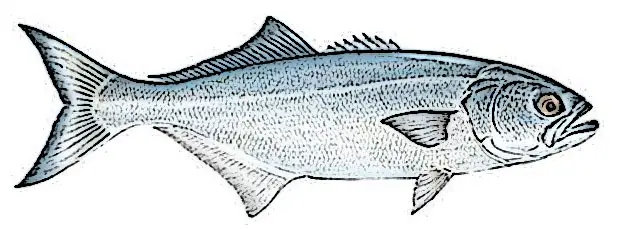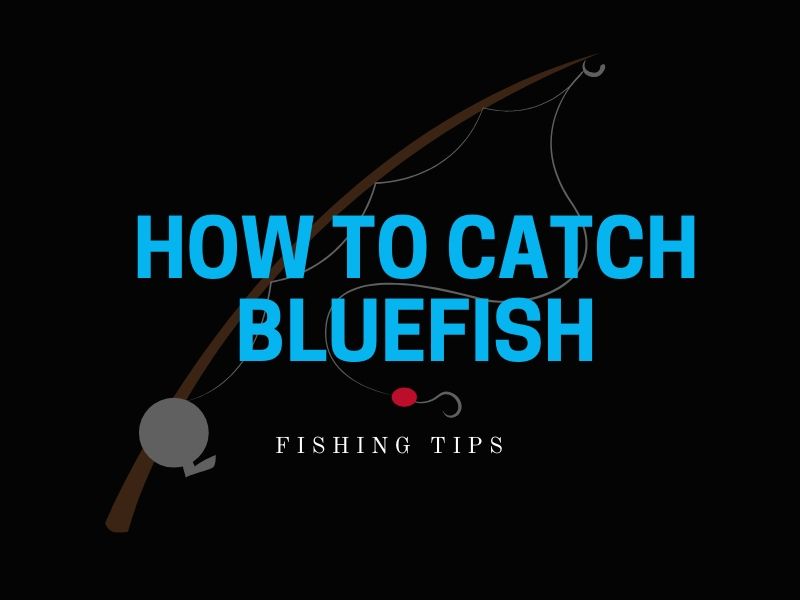Bluefish is a popular game fish found around the world. They are particularly prominent along the coast of the Atlantic Ocean, where the prime spot is for fishing them in the United States. These fish are known to be aggressive feeders which makes fishing them fun for all ages.
In this guide to fishing bluefish, we will cover how to identify bluefish, where to fish for them, their seasonal patterns, the equipment you will need, and a few additional tips to help you catch more bluefish.
Bluefish Identification
Bluefish have a gray blue-green color with white on the lower sides and belly. They have a wide forked tail and spiny dorsal fin. They are a very proportioned fish with a moderately heavy build to them.

Bluefish can vary greatly in terms of size. Smaller ones sometimes called “snappers” can be around 7 inches in size. Though they can get much larger in size. Bigger bluefish can be upwards of 20lbs in size, with the world record bluefish weighing a massive 31 lbs.
Where to Catch Bluefish
Bluefish are a migratory species. They usually move north in spring and summer when the water is warmer. In autumn and fall, they move south. In the colder winter months, they are found offshore.
Younger bluefish are found inshore during spring and summer seasons. When the weather turns colder in fall and winter, they will head offshore and join adult bluefish. They also spawn offshore in spring and summer seasons.
Most commonly you will want to fish inshore for bluefish. Fishing the surf can be extremely productive. Bluefish are usually chasing after large schools of bait, so if you can locate large inshore schools, there will probably be hungry bluefish nearby.
Other productive places to fish bluefish include coastal waters that are near structure or have currents that hold a lot of baitfish, inlets, passes, and sometimes inshore creeks and flats.
What Do Bluefish Eat?
Bluefish have a wide diet depending on the area. Smaller bluefish (snappers) are known to eat crabs, small lobsters, and shrimp. Larger bluefish tend to eat mackerel, squid, menhaden, herring, sand eels, and other schooling fish species.
Best Time to Catch Bluefish
Early morning or early nights are the most productive time to catch bluefish. Try fishing the first couple hours of the morning, or at dusk. They tend to bite frequently during this time.
Bluefish Equipment
Rods and Reels
The best rod for bluefish is a spinning rod. These are versatile and can be used for most places you will fish them. The main thing you need to think about is the casting distance. A medium power fast action rod around 7 foot in length is ideal for fishing piers, docks, and bridges. But if you’re going to be fishing the surf, you may want a longer rod that can cast further.
Lures and Baits
Topwater Poppers
When fishing bays and calm ocean beaches for bluefish, a pencil popper lure is an excellent choice. These lures are designed to chug and splash near the surface to work the fish into a feeding frenzy. Use smaller or mid-sized poppers for bluefish and try changing up the retrieve speed until you figure out what works best.
Diamond Jigs
A favorite of many saltwater anglers, the diamond jig is a tried and true lure for bluefish. They are usually fished from boats but are becoming increasingly popular for fishing bluefish from the surf. They are great for beach casting because they can travel long distances even on windy days.
If you’re using a diamond jig typically they are fished drop-and-retrieve style from boats, but from the surf, the rod is angled and they are retrieved horizontally to place the lure in the water column the bluefish are feeding in.
Spoons
Spoons that wobble and flash can also be very productive. The key is to use a size that closely resembles the baitfish the bluefish are eating. There are a variety of different kinds of spoon lures that can work well when used properly. It takes a little bit of masterly to use a spoon lure properly, but it’s definitely worth it for all the bluefish you can catch with them.
Live Bait or Cut Bait
Live bait tends to work best for catching bluefish, but you can also use smaller chunks if the bait is too big. You have to match the hatch for whatever the bluefish are eating in the area you are fishing but usually, you will want to use menhaden, eel, squid, shrimp, and finger mullet. These all tend to work quite well for attracting bluefish, though oily bait like menhaden and eel are the favorites of many anglers
Fishing Line
For fishing line you can use both monofilament and braided line. Bluefish are known for having sharp teeth though, so you need to make sure your line is strong enough to handle their chompers. Something around 20-30 lbs test for mono line or 40-60 lbs for braided line is a good choice. Many anglers also opt to use a steel wire leader because bluefish are known to chew through lines.
Hooks
For bluefish, we recommend either circle hooks or octopus hooks around 6/0 to 8/0. Just make sure the bait you are using matches your hook size.
Tips to Catch More Bluefish
Use a Wire Leader
Like we stated earlier, bluefish have sharp teeth and are known to chew through lines. That’s why many anglers use a heavy wire or fluorocarbon leader. You don’t want to hook a monster bluefish just to have your line break.
Cast Past the Strike Zone
Bluefish on calmer days can be easily spooked, especially in the flats. If you cast directly on top of them, they are likely to scatter. Instead, cast your bait about 10 feet past where the bluefish are and then reel your presentation through the strike zone. This tactic works great when fishing poppers in the flats or shallows.
Find the Birds
If you’re fishing in an area of the water for bluefish, pay attention if you see any birds. Generally, where the birds are circling or sitting near a patch of water, there is likely a school of fish nearby. The fish that the birds are after are either going to be bluefish, or smaller baitfish that bluefish might be feeding on. So either way, it can be productive to fish this area.
Related Posts:
How to Catch Speckled Trout
Pompano Fishing Tips
Lingcod Fishing Guide
